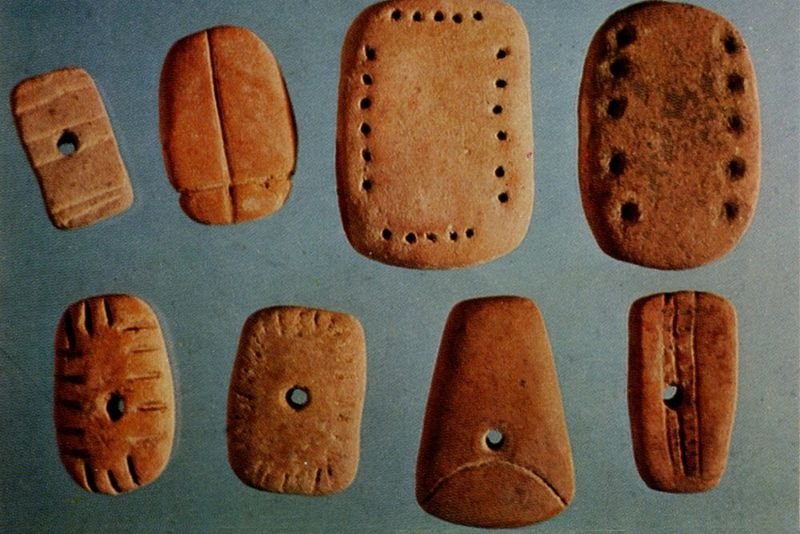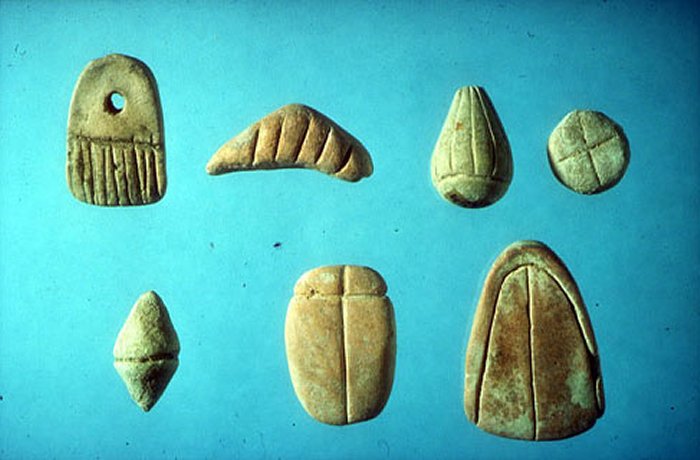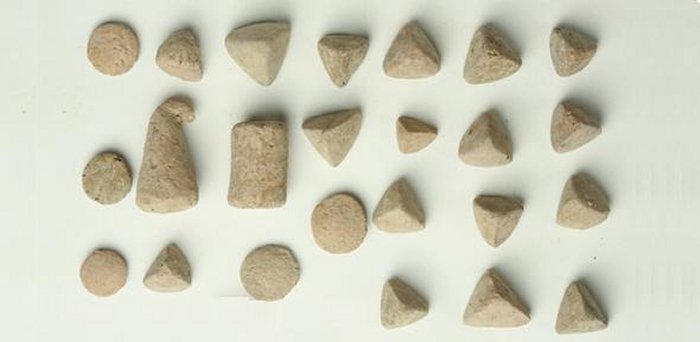Intriguing Sumerian Clay Tokens – An Ancient ‘Book Keeping’ System Used Long After Writing Appeared
AncientPages.com - About 5,000 years ago, people in Mesopotamia used intriguing clay tokens of multiple shapes to count and communicate.
People recorded information about their agricultural goods--including domestic animals and plants and to do so they used small clay tokens that were of different size and shape. Interestingly, archaeologists have discovered clay tokens were used long after writing was invented.
Sumerian clay tokens - Image credit: Denise Schmandt-Besserat
Sumerian clay tokens were often shaped like cones, spheres, disks, cylinders, tetrahedrons and ovoids and their size could vary from 0.5 to 1.25 inches.
Clay Tokens Could Be Used No Matter Of What Language You Spoke
The first tokens appeared in the Near East 7500 B.C. and they were made in the image of the goods they represented. For example, a cone abstracted a measure of grain.
Ovoids were jars of oil, cylinders a sheep or goat and tetrahedrons a person-day of work.
Sumerians used the tokens to count in a different way that we do today. We use abstract numbers, which means that our numbers “one,” “two,” “three,” are independent of the item counted and therefore universally applicable.
It was not so at the time when tokens were used. Between 7500-3100 BC, counting was restricted to selected units of goods, mostly measures of grain, jars of oil, animals and units of labor, based on time and task.
Moreover, each category of item was counted with its own counter, reflecting the fact that counting was “concrete,” meaning that each category of item was counted with a special numeration or special number words specific to that particular item.
See also:
‘Collata Quipu’ May Explain Messages Hidden In Mysterious Writing Of Inca
Controversial Tartaria Tablets: The First Writing System In The World?
The tokens were not difficult to produce. They were made of clay and incised with lines or dots or embellished with pellets of clay. These were then sun-dried or baked in a hearth.
Plain tokens from Jarmo, Iraq, ca. 6500 BC.
One great advantage with clay tokens was that they were non-lingual. It was an easy way to communicate because no matter what language you spoke, both parties understood that a cone meant a measure of grain.
Clay Tokens Were Used Even After The Cuneiform Script Appeared
It was previously thought that clay tokens were no longer used about 3,000 B.C because they were replaced by the cuneiform script, a more elaborate writing system.
Cuneiform tablets were one of the earliest systems of writing invented by the Sumerians. However, while excavating at Ziyaret Tepe, southeast Turkey, archaeologists uncovered a large number of clay tokens that were used as records of trade.
Scientists say clay tokens were integral to administrative functions right across the Assyrian empire – millennia after this system was believed to have vanished. Clay tokens were part of a prehistoric ‘book keeping’ system that continued long after invention of writing.
These clay tokens were found at a dig site in Turkey. Archaeologists think they were used as part of ancient system of record-keeping. Credit: Ziyaret Tepe Archaeological Project
Archaeologists say that while cuneiform writing was a more advanced accounting technology, by combining it with the flexibility of the tokens the ancient Assyrians created a record-keeping system of greater sophistication.
It should be added that Sumerians were not entirely the first to use a token system About 20,000 years ago, Upper Paleolithic people left marks and signs on walls and sticks to communicate. What is unique about clay tokens is that these artifacts represent the first significant step towards communication how storage and retrieval should be handled.
Copyright © AncientPages.com All rights reserved. This material may not be published, broadcast, rewritten or redistributed in whole or part without the express written permission of AncientPages.com
More From Ancient Pages
-
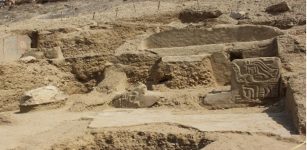 Pre-Inca Temple With Colored Paintings And Carved Sculptures Discovered At The Los Paredones Archaeological Complex, Peru
Archaeology | Jul 8, 2024
Pre-Inca Temple With Colored Paintings And Carved Sculptures Discovered At The Los Paredones Archaeological Complex, Peru
Archaeology | Jul 8, 2024 -
 Xochicalco: Stunning Ruins Of Sacred City Linked To Maya and Aztecs Civilizations
Featured Stories | Feb 26, 2018
Xochicalco: Stunning Ruins Of Sacred City Linked To Maya and Aztecs Civilizations
Featured Stories | Feb 26, 2018 -
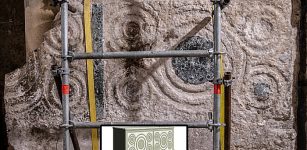 Graffiti Reveals Crusaders’ Beautiful Altar In The Church Of The Holy Sepulchre
Archaeology | Jul 24, 2024
Graffiti Reveals Crusaders’ Beautiful Altar In The Church Of The Holy Sepulchre
Archaeology | Jul 24, 2024 -
 Babylon Excavation Uncovers 478 Artifacts, Including Cuneiform Tablets and Seals
Archaeology | Oct 17, 2024
Babylon Excavation Uncovers 478 Artifacts, Including Cuneiform Tablets and Seals
Archaeology | Oct 17, 2024 -
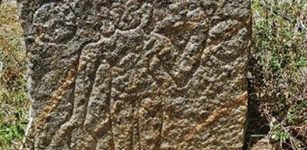 500-Year-Old Vaishnava Saint Sculptures Discovered
Archaeology | Oct 15, 2015
500-Year-Old Vaishnava Saint Sculptures Discovered
Archaeology | Oct 15, 2015 -
 European Bronze Age Treasure Of Villenna Has Artifacts Made Of Meteoric Iron
Archaeology | Feb 12, 2024
European Bronze Age Treasure Of Villenna Has Artifacts Made Of Meteoric Iron
Archaeology | Feb 12, 2024 -
 Why Were Neolithic Houses Always Built Counterclockwise?
Archaeology | Jan 13, 2020
Why Were Neolithic Houses Always Built Counterclockwise?
Archaeology | Jan 13, 2020 -
 Will Star Goddess Astraea Return To Earth With Second Golden Age Or Apocalypse?
Featured Stories | Aug 1, 2020
Will Star Goddess Astraea Return To Earth With Second Golden Age Or Apocalypse?
Featured Stories | Aug 1, 2020 -
 Skull Of Mysterious, Extinct Cousin Of Neanderthals Recreated From A Fossilized Finger
Archaeology | Sep 19, 2019
Skull Of Mysterious, Extinct Cousin Of Neanderthals Recreated From A Fossilized Finger
Archaeology | Sep 19, 2019 -
 Mysterious Scrolls And Artifacts Discovered Inside Ancient Buddha Statuette
Archaeology | May 9, 2018
Mysterious Scrolls And Artifacts Discovered Inside Ancient Buddha Statuette
Archaeology | May 9, 2018 -
 Ancient Underwater ‘Lion City’ Rests Beneath The Thousand Island Lake
News | Feb 11, 2014
Ancient Underwater ‘Lion City’ Rests Beneath The Thousand Island Lake
News | Feb 11, 2014 -
 Did An Extraterrestrial Spacecraft Land In Ancient China? Remarkable UFO Accounts From The Past
Ancient Mysteries | Nov 17, 2014
Did An Extraterrestrial Spacecraft Land In Ancient China? Remarkable UFO Accounts From The Past
Ancient Mysteries | Nov 17, 2014 -
 Amazon Forest Communities Disappeared Long Before 1492 Arrival Of Europeans
Archaeology | Jun 19, 2019
Amazon Forest Communities Disappeared Long Before 1492 Arrival Of Europeans
Archaeology | Jun 19, 2019 -
 Unsolved Mystery Of The Huldremose Woman: One Of The Best Preserved Bog Bodies Ever Found
Civilizations | Jan 9, 2017
Unsolved Mystery Of The Huldremose Woman: One Of The Best Preserved Bog Bodies Ever Found
Civilizations | Jan 9, 2017 -
 Stribog – Slavic God Of Winds Associated With Destruction, Harvest, Evil And Good
Featured Stories | Jul 1, 2019
Stribog – Slavic God Of Winds Associated With Destruction, Harvest, Evil And Good
Featured Stories | Jul 1, 2019 -
 Ancient European Languages Shed Light On A Great Migration And Weather Vocabulary
Archaeology | Aug 14, 2023
Ancient European Languages Shed Light On A Great Migration And Weather Vocabulary
Archaeology | Aug 14, 2023 -
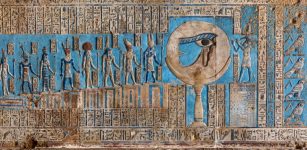 Secrets Of Egyptian Blue – World’s Oldest Artificial Pigment And Its Extraordinary Properties
Featured Stories | May 10, 2021
Secrets Of Egyptian Blue – World’s Oldest Artificial Pigment And Its Extraordinary Properties
Featured Stories | May 10, 2021 -
 Archaeology Sheds Light On Why Some Ancient Societies Were More Unequal Than Others
Featured Stories | May 25, 2022
Archaeology Sheds Light On Why Some Ancient Societies Were More Unequal Than Others
Featured Stories | May 25, 2022 -
 On This Day In History: Bishop of Gloucester John Hooper is Burned At The Stake For Heresy- On Feb 9, 1555
News | Feb 9, 2017
On This Day In History: Bishop of Gloucester John Hooper is Burned At The Stake For Heresy- On Feb 9, 1555
News | Feb 9, 2017 -
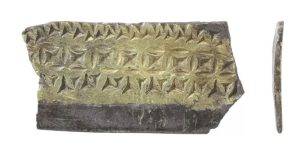 What Is The Roman Silver Fragment Found In Norfolk? Experts Are Baffled
Archaeology | Mar 27, 2023
What Is The Roman Silver Fragment Found In Norfolk? Experts Are Baffled
Archaeology | Mar 27, 2023

